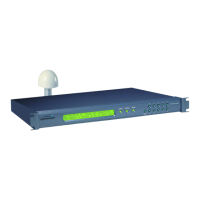CHAPTER THREE
Channel Four controls MUX outputs on J7.
Pushing the “2” front panel keyboard switch cycles through the outputs available for the
respective channel selected.
The choices are as follows (see the paragraph entitled “Optional Pulse Rate Outputs” in Chapter
One):
10MHz 100Hz LOCKED
5MHz 10Hz/1PPH* +5 VOLTS
1MHz 1Hz 1PPS
100KHz .1Hz DC CODE
10KHz/2PPH* 1PPM
1KHz TRACKING
1PPS is a 30-50uS wide pulse, positive edge on-time.
Tracking output is a TTL low when
not tracking and a TTL high when tracking.
Locked output is a TTL low when
not locked and a TTL high when locked.
* Models ET6000 and ET6010 output 10KHz and 10Hz. Model ET6500 outputs 2PPS and
1PPH.
Note: The MUX outputs can also be read and selected via the RS-232 I/O port. See paragraphs
titled “Request MUX Output” and “Set MUX Output” in Chapter Four of this User’s
Guide.
The standard configuration is as follows:
J4 - TRACKING (TTL)
J5 - LOCKED (TTL)
J6 - 1PPS
J7 - 10MHz SINE WAVE
J8 - IRIG B (AC)
J9 - IRIG B (DC)
J10 - 1PPS INPUT (Time Interval Measurement)
Configurations other than the above standard will be found in the GPS Option/Connector
Configuration Sheet included in this User’s Guide.
The internal jumper pins are shown in Figure 2-3 in Chapter Two.
Jumpers J14 and J24 are associated with BNC J4. Jumpers J15 and J25 are associated with BNC
J5, etc. The basic circuitry is explained in the following example:
3-22 ET6xxx ExacTime GPS TC & FG (Rev C) Symmetricom Inc

